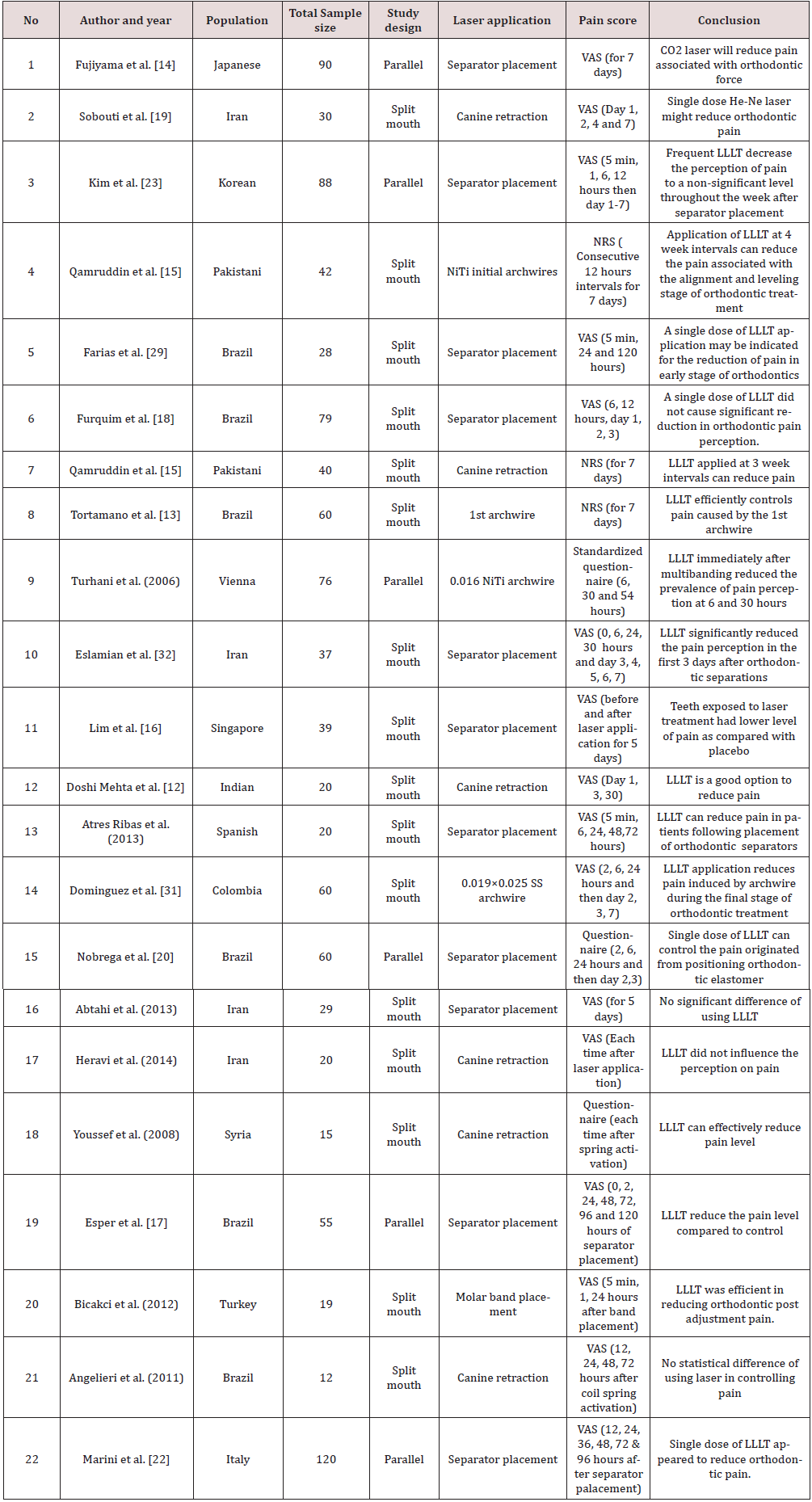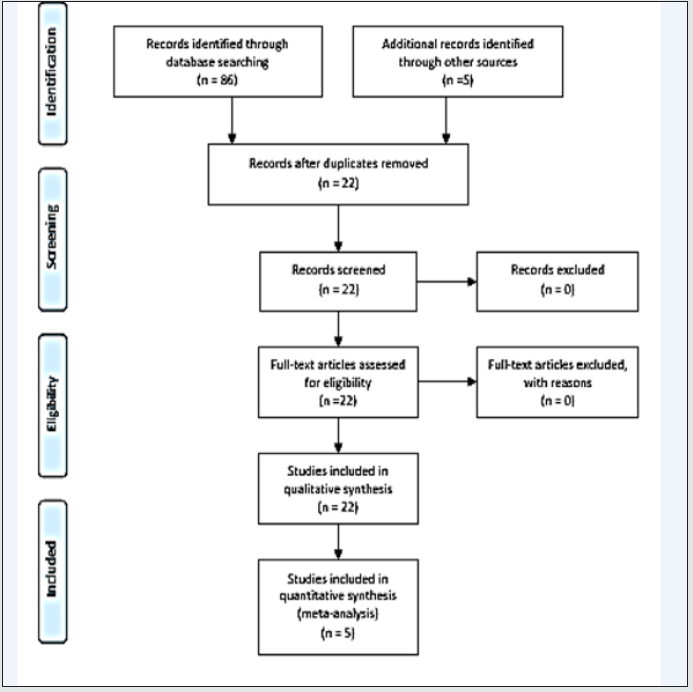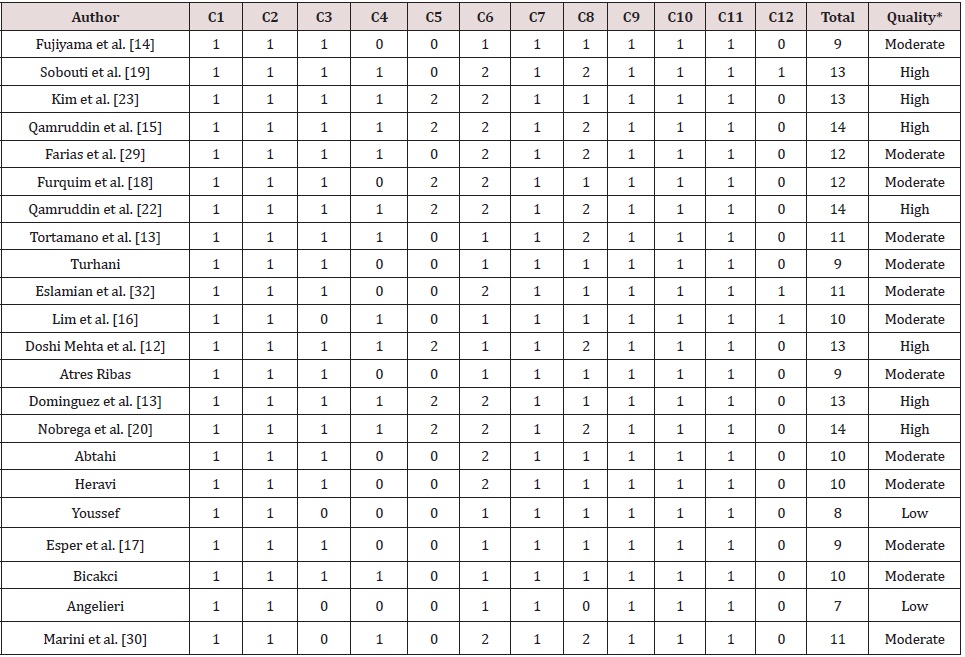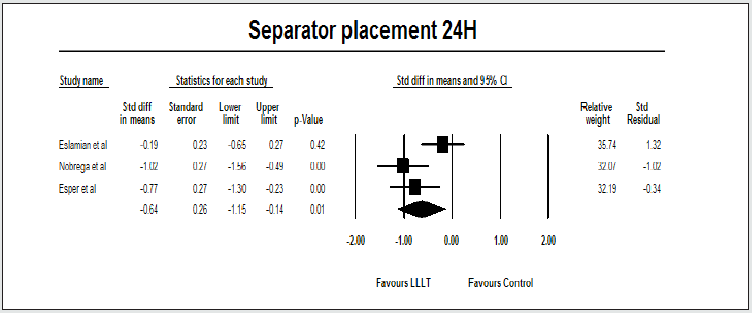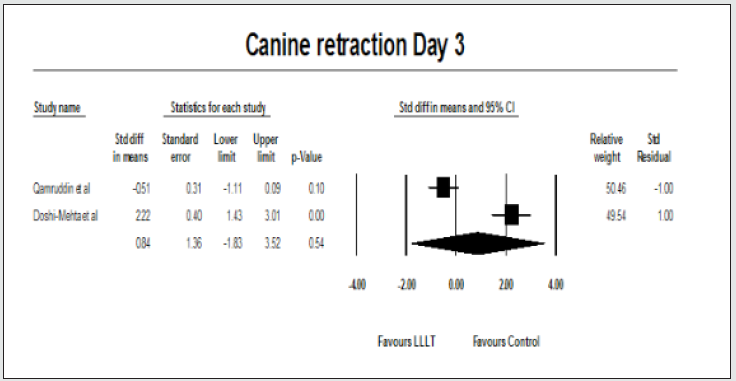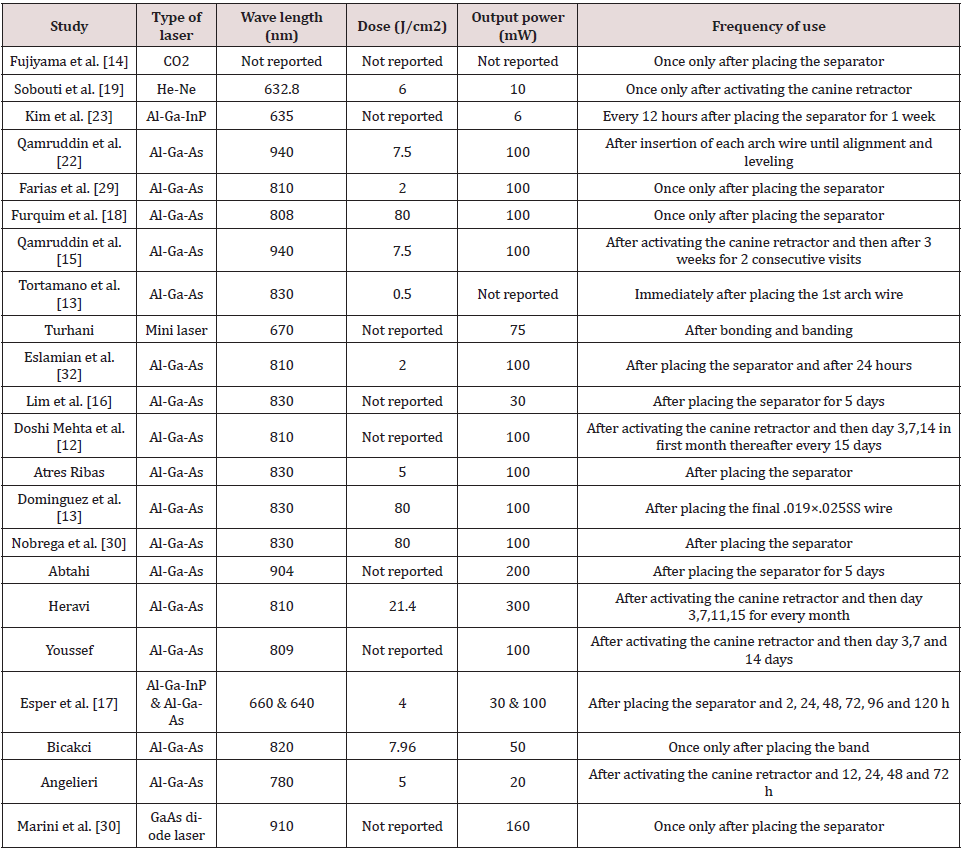
Lupine Publishers Group
Lupine Publishers
Menu
ISSN: 2637-6679
Research Article(ISSN: 2637-6679) 
Low level laser therapy and its effect on pain during orthodontic treatment: A systematic review and meta-analysis Volume 6 - Issue 2
Fazal Shahid1, Norma Ab Rahman2, Mohd Fadhli Khamis3, Adam Husein4, Mohammad Khursheed Alam5, Shifat A Nowrin6
- 1,2,6Orthodontic Unit, School of Dental Science, Universiti Sains Malaysia, Kubang Kerian, Kelantan, Malaysia
- 3Forensic Dentistry/Oral Biology Unit, School of Dental Science, Universiti Sains Malaysia, Kubang Kerian, Kelantan, Malaysia
- 4Prosthodontics Unit, School of Dental Science, Universiti Sains Malaysia, Kubang Kerian, Kelantan, Malaysia
- 5Orthodontic Department, College of Dentistry, Jouf University, Sakaka, KSA
Received: February 04, 2021 Published: March 09, 2021
Corresponding author: Norma Ab Rehman, Orthodontic Unit, School of Dental Science, Universiti Sains Malaysia, Kubang Kerian, Kelantan, Malaysia.
DOI: 10.32474/RRHOAJ.2021.06.000231
Abstract
Introduction: Application of low-level laser therapy (LLLT) in reducing the pain associated with orthodontic treatment is still debated. Hence, the aim of this systematic review is to reconnoiter the effect of LLLT in pain allied with different orthodontic procedure.
Methods: Literature search in Scopus, PubMed and Science direct data bases was performed by two independent reviewers. In addition, manual hand search and references were checked to fine relevant studies. Systematic review and meta-analysis were conducted using the data entered into electronic data bases until 31st August 2018.
Results: On the basis of the different data bases search, 22 studies were included for the systematic review and total 5 studies were selected for meta-analysis. Mean pain score and standard deviation were used to evaluate the effectiveness of LLLT relation with pain in orthodontic treatment. There is significant positive association with laser application in reducing pain in elastomeric separator placement in 24 hours (P value 0.01) and 72 hours (P value 0.02). However, in terms of canine retraction, LLLT does not showed significant difference in reducing pain.
Conclusion: More clinical trials in the effectiveness of low-level laser therapy in relation with pain perception of orthodontic treatment is necessary to define better specificity of conceivable interaction.
Keywords: Pain Perception; LLLT; Orthodontic Treatment
Introduction
One of the most common side effects of orthodontic treatment is pain or discomfort when patients exposed to orthodontic forces [1]. More or less 90% of patients claimed of suffering pain during orthodontic treatment. However, the intensity of the pain might vary in different stages of treatment [2] . The most intense pain usually occurs 24 hours after separator or initial wire placement and its gradually decrease over a week [3]. Hence, pain associated with orthodontic treatment is one of the reasons patients feel discouraged to continue treatment. Nevertheless, orthodontic pain is generally underestimated and neglected, though it has a significant clinical value [2,4].After placing the first wire or separator, patients are sometimes prescribed anti- inflammatory and analgesics drugs to avoid the pain [5]. However, using any drugs might have potential influence on orthodontic tooth movement and its contentious due to the adverse systemic side effects [6]. Moreover, other pain management procedures for instance vibratory stimulation of the periodontal ligament [7], anesthetic gels [8], transcutaneous electrical nerve stimulations [9], xylitol chewing gums [8] yielded fluctuating results. In recent years, low level laser therapy (LLLT) has been increased in attention for reducing pain associated with orthodontic tooth movement. Moreover, it considered as a safe procedure compare to the other traditional approaches[10]. LLLT plays an important role in increasing blood supply and stimulate the regaining of dental tissue[11]. Several studies showed that LLLT reduces the pain during orthodontic treatment [12-16]. However, few studies showed no significant difference in terms of pain with laser applications [16-18].
There are different types of lasers are being used in dentistry for reducing the pain such as carbon dioxide (CO2) laser [14], helium-neon (He-Ne) laser [19] and diode laser [12, 15, 20]. However, diode laser which is also known as semi-conductive laser is widely used in dentistry due to its low cost and comparatively compact feature. Diode laser can infiltrate into deep tissues based on its wavelength (usually 600-1000 nm) which can control the pain associated with orthodontic tooth movement[21]. In orthodontic pain management, GaAlAs laser (wavelength 780- 890 nm) has been widely used [12, 15, 17, 22] though other types of diode laser InGaAlP laser (wavelength 630-700 nm) is also showing a positive result in reducing the pain[23]. Despite, a number of clinical trials observed the effect of LLLT in reducing the pain, a little attention has been given to the precise properties of the most popular diode laser. Therefore, a systematic review is mandatory for evidence based clinical practice and results. In this current systematic review, effects of LLLT in pain associated with orthodontic treatment has been evaluated based on the outcome of different clinical researches.
Materials and Methods
This systematic review followed the PRISMA (Preferred Reporting Items for systematic reviews and Meta-Analysis) guideline to select all the studies (Figure 1). Moreover, a distinct review question was established following population, intervention, comparison, outcome and study design (PICOS) strategy (Table 1).
Formulating review question
Current study intent to answer the following question: In
patients undergoing orthodontic treatment, can LLLT alter the pain
perception in humans when compared to the control group?
Formulating review question
Current study intent to answer the following question: In patients undergoing orthodontic treatment, can LLLT alter the pain perception in humans when compared to the control group?
Inclusion and exclusion criteria
All the articles should meet the following prerequisite criteria to include in this systematic review.
Inclusion criteria were as follows:
a) Patients are undergoing orthodontic treatment
b) RCT, CCT or quasi RCT conducted to diminish acute pain with
using LLLT
c) Control group was used either with placebo or no use of laser
d) Pain scores were measured using visual analog scale (VAS),
numeric rating score (NRS) or any questionnaire.
Exclusion criteria were as follows:
a) Case reports, review articles or conference proceeding
b) Animal studies
c) Incomplete information about laser
Literature search strategy
Literature search was conducted on Science Direct, PubMed and Scopus databases till 31st August 2018. For searching literatures, following key words were used: “LLLT or low-level laser therapy or laser” + “orthodontic treatment or orthodontic or fixed appliances” + “pain or discomfort”. No restrictions were levied on language, populations, treatment stage or sample size. Selected literatures were thoroughly checked, and their references were re-checked for any literature not found in selected databases. All the articles were inspected by two independent reviewers (FS and SAN) and included in current review which meet the eligible criteria.
Quality assessment of specific studies
Each selected articles were evaluated based on methodological quality assessments .24. Methodological quality scores were calculated and ranged from 0 to 15. All studies were divided into 3 categories: low, moderate and high from score 0 to 8, 9 to12 and 13 to 15, respectively.
Meta analysis
A meta-analysis was conducted based on pain score in similar days with laser applications. Study 10, 15 and 19 (Table 2) for separator placement and study 7 and 12 (Table 2) for canine retraction were chosen for meta-analysis.
Statistical analysis
All statistical analysis was conducted using IBM SPSS statistics for Windows, version 22.0 (IBM Co., Armonk, NY, USA) and Comprehensive Meta-Analysis (CMA) software version 3 (Biostat, Englewood, NJ, USA). The statistical significance (P value) set <0.05 for hypothesis test. Cohen’s kappa analysis was performed to assess the inter-observer agreement for the quality assessments. Kappa scores are graded as near perfect (0.81-1), substantial (0.61- 0.80), moderate (0.41-0.60), fair (0.21-.040) and poor (<0.20). For pain score, mean and standard deviation (SD) were adopted. Heterogeneity was verified using I2 and Q statistics. I2 <50% and P value of Q statistics >0.10 determined no heterogeneity across the studies. Funnel plots were used to check the publication bias using egger’s and Begg’s test. A P value >0.05 was indicated no bias among the studies.
Results
Search result
Through the electronic search, initially we identified 86 studies: 60 from Scopus, 20 from Science Direct and 6 from PubMed. Furthermore, all the references were manually checked for other relevant studies and 5 more studies were included. PRISMA guideline was followed to scrutinize all the studies into current systematic review (Figure 1). After removing the duplicates and exclusion criteria 22 studies were included. Finally, total 22 studies were selected for this review (Table 2). Two independent reviewers were inspected all the studies properly to avoid any bias in selection procedure.
Analysis of selected studies
Quality analysis was performed among the selected studies following criteria described by Almeida et al (2016) [24]. Among 22 studies, total 7, 13 and 2 studies were classified as high quality (13-15 points), moderate quality (9-12 points) and low quality (0-8 points) study, respectively (Table 3). For quality assessment Cohen’s kappa score was 0.840 which is near perfect level of inter examiner agreement. Types of laser, specifications and frequency of applying laser were checked thoroughly from the selected articles which showed in (Table 4). Most of the studies used Al-Ga-As laser in the range of 640 to 940 wavelength. Laser application mostly seen after elastomeric separator placement followed by canine retraction, arch wire and molar band placement. VAS, NRS and selfdesigned questionnaire were used to assess the pain perception. However, different studies checked the pain score in different days. The analysis of the association of pain with LLLT in separator placement showed that there is significant positive association with laser application in reducing the pain (Figure 2, 3 and Table 5). However, in terms of canine retraction, LLLT does not showed significant difference in reducing pain (Figure 4). Both statistical and clinical heterogeneity were inspected among these studies in LLLT application of separator placement and canine retraction stage. A forest plot revealed that, pain subsided significantly in LLLT group compared to control in both times (24 and 72 hours) with insignificant heterogeneity in 72 hours (Table 6). Moreover, sensitivity test was also conducted after omitting one study to check the influence on pooled result nevertheless it persists same. Begg’s and Egger’s test showed no publication bias among the studies in separator placement (Table 7 and Figure 5). However, these tests couldn’t be performed for canine retraction as only 2 studies were included while minimum 3 studies need to include to perform Begg’s and Egger’s test.
Discussion
In current systematic review we have selected 22 studies for quality assessment after an extensive search. Methodological quality assessment revealed only 7 out of 22 studies consist of sound methodology. Furthermore, 13 studies fall in moderate group and 2 in low group. After further screening, we found most of the clinical trials were randomly selected the voluntary subjects either from dental school or patients from hospital. No proper sample size calculation has been done. Whereas, sample size is considered to be a very important factor in any clinical trial [25, 26]. Moreover, most of the studies have flaws in selection criteria and randomization process. 10 out of 22 studies were mentioned only about inclusion criteria and ignore the exclusion criteria. In addition, only 8 studies mentioned the randomization and blinding protocol properly. Individual 2 studies discussed the limitation of the study. Therefore, definite studies may acquaint with bias owing to methodological imprecisions.
Included studies were conducted in 13 different countries with varying total number of subjects. Study designs were different. Among 22 studies, 5 studies were based on parallel design and rest were split mouth design. Split mouth study designs might have advantages over parallel study design due to the efficiency and decrease requirement of sample. However, lack of uniformity in allocation segment, carry across effects or contamination is the main disadvantages for split mouth studies. Moreover, split mouth study design should be carried out when proper sample size has been calculated [27]. As there is a lack of sample size calculation in most of the studies, methodological soundness is still questionable among most of the selected studies. Mainstream of the studies were used GaAlAs diode laser with diversified application methods and time duration. It is difficult to perform quantitative synthesis with varying of data and outcome [28]. Pain perception was mostly checked after placing elastomeric separators (10 studies) following canine retraction (7 studies), arch wire (4 studies) and molar band placement (1 study) (Table 2). The pain scores were checked in different time in different studies selected in current systematic review. However, Day 1 (24 hours) and Day 3 (72 hours) were most common selected time for checking pain status after laser application. 8 among 22 studies were used GaAlAs laser and checked the pain perception commonly at day 1 and day 3. However, 3 studies checked the median value of pain perception [16,18,29,2] studies displayed the results with graphs without any numeric result presented [30,31]. Yet only 3 studies with pain perception after placing the separator were presented with mean pain score and standard deviation which we included in metaanalysis [17,20,32]. On the other hand, in terms of laser application during canine retraction stages, 2 studies presented the detail result in pain perception for day 3 [12, 15].
Though all the studies included for quantitative synthesis showed positive outcome, both Q statistics and I2 test was performed to check the heterogeneity. Pain score at 24 hours after laser application of separator placement and 72 hours of canine retraction indicated significant heterogeneity among studies. However, 72 hours after laser application of separator placement showed insignificant Q statistics and I2. The laser application methods and dosimetry might be affecting the comparability of the studies. Therefore, future research is advisable to adopt a common model for assessing LLLT effects on orthodontic pain. Nevertheless, clinical heterogeneity is always present in meta-analysis due to study design, intervention, outcome and sample size. This metaanalysis also represents clinical heterogeneity on study background, sample size, ethnic background and outcomes.
Conclusion
Current systematic review and meta-analysis concluded that LLLT might have positive aspect of reducing pain in different orthodontic procedure. However, the heterogeneity and the varying protocols of laser application cannot provide sufficient evidence to judge whether LLLT is effective in reducing orthodontic pain. Further clinical trials with better study design, controlled laser dosimetry and appropriate sample size is recommended to provide more meaningful evidence for the clinical application of laser.
Acknowledgement
RU grant 1001/PPSG/812154 and Vice Chancellor Award.
References
- Oliver R, Knapman Y (1985) Attitudes to orthodontic treatment. British Journal of Orthodontics 12: 179-188.
- Krukemeyer AM, Arruda AO, Inglehart MR (2009) Pain and orthodontic treatment: patient experiences and provider assessments. Angle orthod 79: 1175-1181.
- Law SLS, Southard KA, Law AS, Logan HL, Jakobsen JR (2000) An evaluation of preoperative ibuprofen for treatment of pain associated with orthodontic separator placement. Am J Orthod Dentofac Orthop 118: 629-35.
- Bergius M, Berggren U, Kiliaridis S (2002) Experience of pain during an orthodontic procedure. Eur J Orl Sci 110: 92-98.
- Bird SE, Williams K, Kula K (2007) Preoperative acetaminophen vs ibuprofen for control of pain after orthodontic separator placement. Am J Orthod Dentofac Orthop 132: 504-510.
- Gameiro GH, Pereira-Neto JS, MAGNANI MBBDA, Nouer DF (2007) The influence of drugs and systemic factors on orthodontic tooth movement. The Effect of Drugs and Systemic Factors on Orthodontic Dental Movement.
- Marie S, Powers M, Sheridan J (2003) Vibratory stimulation as a method of reducing pain after orthodontic appliance adjustment. J Clin Orthod 37: 205-208.
- Shenoy N, Shetty S, Ahmed J, Shenoy A (2013) The pain management in orthodontics. Journal of clinical and diagnostic research: JCDR 7:pp.1258.
- Weiss DD, Carver DM (1994) Transcutaneous electrical neural stimulation for pain control. J Clin Orthod 28: 670-672.
- Xiaoting L, Yin T, Yangxi C (2010) Interventions for pain during fixed orthodontic appliance therapy: A systematic review. Angle Orthod 80: 925-932.
- Abi Ramia LBP, Sasso Stuani A, Sasso Stuani MB, de Moraes Mendes A (2010) Effects of low-level laser therapy and orthodontic tooth movement on dental pulps in rats. Angle Orthod 80: 116-122.
- Doshi Mehta G, Bhad-Patil WA (2012) Efficacy of low-intensity laser therapy in reducing treatment time and orthodontic pain: a clinical investigation. Am J Orthod Dentofac Orthop 141: 289-97.
- Tortamano A, Lenzi DC, Haddad ACSS, Bottino MC, Dominguez GC (2009) Low-level laser therapy for pain caused by placement of the first orthodontic archwire: a randomized clinical trial. Am J Orthod Dentofac Orthop 136: 662-667.
- Fujiyama K, Deguchi T, Murakami T, Fujii A, Kushima K, et al. (2008) Clinical effect of CO2 laser in reducing pain in orthodontics. Angle Orthod 78: 299-303.
- Qamruddin I, Alam MK, Mahroof V, Fida M, Khamis MF, et al.(2017) Effects of low-level laser irradiation on the rate of orthodontic tooth movement and associated pain with self-ligating brackets. Am J Orthod Dentofac Orthop 152: 622-630.
- Lim HM, Lew KK, Tay DK (1995) A clinical investigation of the efficacy of low-level laser therapy in reducing orthodontic post adjustment pain. Am J Orthod Dentofac Orthop 6: 614-622.
- Esper MÂLR, Nicolau RA, Arisawa EÂLS (2011) The effect of two phototherapy protocols on pain control in orthodontic procedure-a preliminary clinical study. Lasers Med Sci 26: 657-663.
- Furquim RD, Pascotto RC, Rino Neto J, Cardoso JR, Ramos AL (2015) Low-level laser therapy effects on pain perception related to the use of orthodontic elastomeric separators. Dental Press J Orthod 20: 37-42.
- Sobouti F, Khatami M, Chiniforush N, Rakhshan V, Shariati M (2015) Effect of single-dose low-level helium-neon laser irradiation on orthodontic pain: a split-mouth single-blind placebo-controlled randomized clinical trial. Prog Orthod 16:32.
- Nobrega C, Koga da Silva EM, Macedo CRd (2013) Low-Level Laser Therapy for Treatment of Pain Associated with Orthodontic Elastomeric Separator Placement: A Placebo-Controlled Randomized Double-Blind Clinical Trial. Photomed Laser Surg 31(1):10-16.
- Sun G, Tunér J (2004) Low-level laser therapy in dentistry. Dental Clinics of North America 48: 1061-1076.
- Qamruddin I, Alam MK, Abdullah H, Kamran MA, Jawaid N, et al. (2018) Effects of single-dose, low-level laser therapy on pain associated with the initial stage of fixed orthodontic treatment: A randomized clinical trial. Korean J Orthod 48: 90-97.
- Kim WT, Bayome M, Park JB, Park JH, Baek SH, et al.(2012) Effect of frequent laser irradiation on orthodontic pain: a single-blind randomized clinical trial. Angle Orthod 83: 611-616.
- de Almeida VL, de Andrade Gois VL, Andrade RNM, Cesar CPHAR, de Albuquerque-Junior RLC, et al. (2016) Efficiency of low-level laser therapy within induced dental movement: a systematic review and meta-analysis. J Photochem Photobiol B 158: 258-266.
- Lachin JM (1981) Introduction to sample size determination and power analysis for clinical trials. Cont Clin Trials 2: 93-113.
- Eng J (2003) Sample size estimation: how many individuals should be studied? Radiology 227: 309-313.
- Smaïl Faugeron V, Fron Chabouis H, Courson F, Durieux P (2014) Comparison of intervention effects in split-mouth and parallel-arm randomized controlled trials: a meta-epidemiological study. BMC Med Res Methodol 14:64.
- Moher D, Liberati A, Tetzlaff J, Altman DG (2009) Preferred reporting items for systematic reviews and meta-analyses: the PRISMA statement. Ann Int Med 151: 264-269.
- Farias RD, Closs LQ, Miguens Jr SAQ (2015) Evaluation of the use of low-level laser therapy in pain control in orthodontic patients: A randomized split-mouth clinical trial. Angle Orthod 86:193-198.
- Marini I, Bartolucci ML, Bortolotti F, Innocenti G, Gatto MR, Bonetti GA (2015) The effect of diode superpulsed low-level laser therapy on experimental orthodontic pain caused by elastomeric separators: a randomized controlled clinical trial. Lasers Med Sci 30: 35-41.
- Domínguez A, Velásquez S (2013) Effect of low-level laser therapy on pain following activation of orthodontic final archwires: a randomized controlled clinical trial. Photomed Laser surg 31: 36-40.
- Eslamian L, Borzabadi Farahani A, Hassanzadeh Azhiri A, Badiee MR, Fekrazad R (2014) The effect of 810-nm low-level laser therapy on pain caused by orthodontic elastomeric separators. Lasers Med Sci 29: 559-564.

Top Editors
-

Mark E Smith
Bio chemistry
University of Texas Medical Branch, USA -

Lawrence A Presley
Department of Criminal Justice
Liberty University, USA -

Thomas W Miller
Department of Psychiatry
University of Kentucky, USA -

Gjumrakch Aliev
Department of Medicine
Gally International Biomedical Research & Consulting LLC, USA -

Christopher Bryant
Department of Urbanisation and Agricultural
Montreal university, USA -

Robert William Frare
Oral & Maxillofacial Pathology
New York University, USA -

Rudolph Modesto Navari
Gastroenterology and Hepatology
University of Alabama, UK -

Andrew Hague
Department of Medicine
Universities of Bradford, UK -

George Gregory Buttigieg
Maltese College of Obstetrics and Gynaecology, Europe -

Chen-Hsiung Yeh
Oncology
Circulogene Theranostics, England -
.png)
Emilio Bucio-Carrillo
Radiation Chemistry
National University of Mexico, USA -
.jpg)
Casey J Grenier
Analytical Chemistry
Wentworth Institute of Technology, USA -
Hany Atalah
Minimally Invasive Surgery
Mercer University school of Medicine, USA -

Abu-Hussein Muhamad
Pediatric Dentistry
University of Athens , Greece

The annual scholar awards from Lupine Publishers honor a selected number Read More...

.png)



